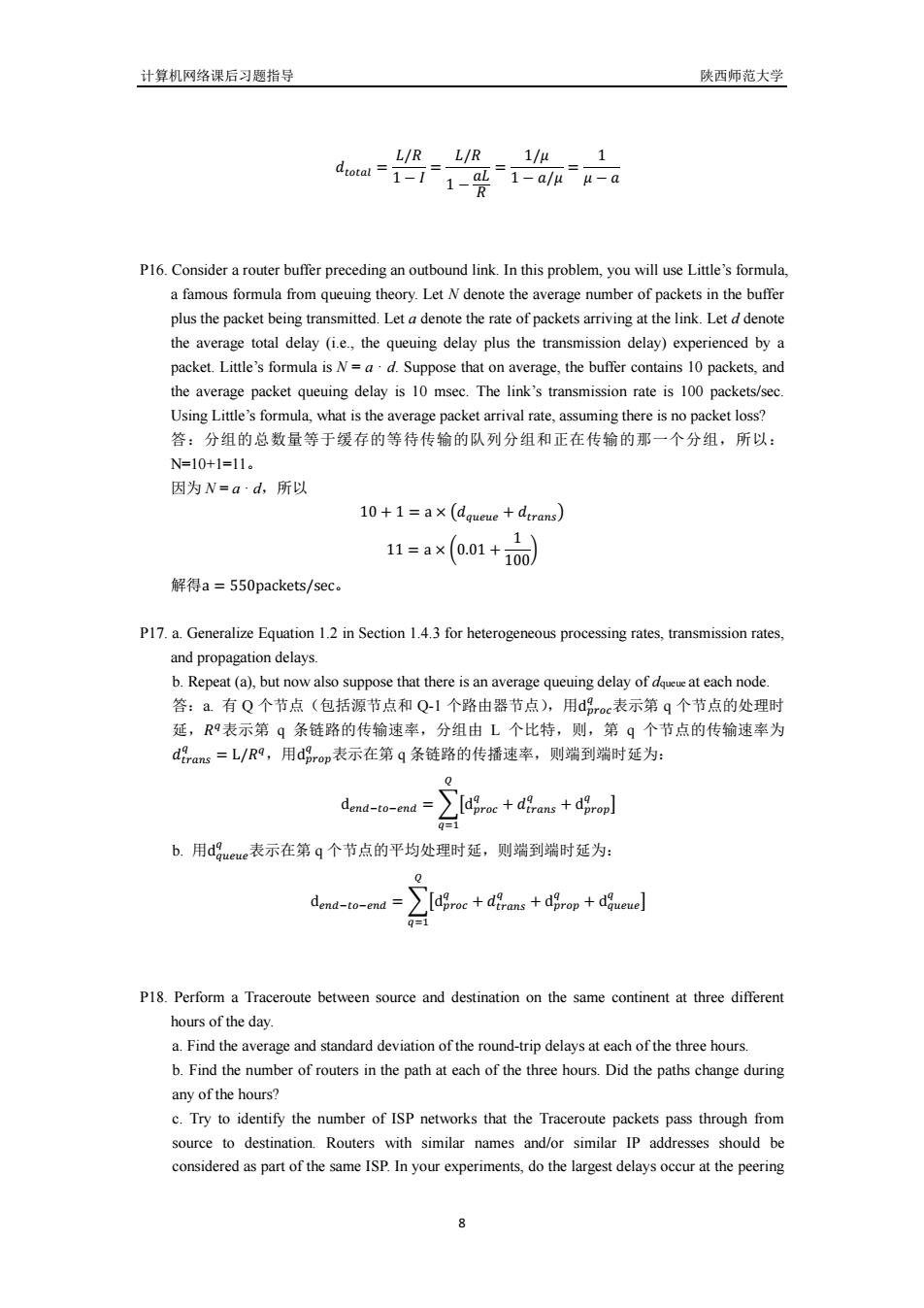正在加载图片...

计算机网络课后习圈指导 陕西师范大学 得得路品 P16.Consider arouer buffer precedingan oubound link In this problem,you will use Litle'sformula a famous formula from queuing theory.Let N denote the average number of pac in the bulr plus the packet being transmitted.Leta denote the rate of packets arriving at the link Letd denote the average total delay (i.e.,the queuing delay plus the transmission delay)experienced by a packet.Little's formula is N-ad.Suppose that on average,the buffer contains 10 packets,and the average packet queuing delay is 10 msec.The link's transmission rate is 100 packets/sec Using Little's formula.what is thea uming there is no packet oss? 答:分组的总数量等于缓存的等特传输的队列分组和正在传输的那一个分组,所以 N=10+1=11。 因为N=ad,所以 10+1=ax(dqueue +dtrans) 1=a×001+100 解得a=550 packets/sec. P17.a Generalize Equation 1.2 in Section 1.4.3 for heterogeneous processing rates,transmission rates, b.Rep (a)but nov se that there is an a euing delay of dat each node 答:有Q个节点(包括源节点和Q-1 延,R9表示第q条链路的传输速率,分组由L个比特,则,第q个节点的传输速率为 d8as=L/R,用d品rop表示在第q条链路的传播速率,则端到端时延为: dend-te-mddirame b.用daueve表示在第q个节点的平均处理时延,则端到端时延为: demd-tonrdiramsro 0=1 P18.Perform a Traceroute between source and destination on the same continent at three different hours of the day. a.Find the average and standard deviation of the round-trip delays at each of the three hours. b.Find in the path the three hours.Did the paths change uring any of the hours? c.Try to identify the number of ISP networks that the Traceroute packets pass through from source to destination.Routers with similar names and/or similar IP addresses should be considered as part of the same ISP.In your experiments.do the largest delays occur at the peering计算机网络课后习题指导 陕西师范大学 8 = / 1− = / 1 − = 1/ 1 − / = 1 − P16. Consider a router buffer preceding an outbound link. In this problem, you will use Little’s formula, a famous formula from queuing theory. Let N denote the average number of packets in the buffer plus the packet being transmitted. Let a denote the rate of packets arriving at the link. Let d denote the average total delay (i.e., the queuing delay plus the transmission delay) experienced by a packet. Little’s formula is N = a · d. Suppose that on average, the buffer contains 10 packets, and the average packet queuing delay is 10 msec. The link’s transmission rate is 100 packets/sec. Using Little’s formula, what is the average packet arrival rate, assuming there is no packet loss? 答:分组的总数量等于缓存的等待传输的队列分组和正在传输的那一个分组,所以: N=10+1=11。 因为 N = a · d,所以 10 + 1=a × + 11 = a × 0.01 + 1 100 解得a = 550packets/sec。 P17. a. Generalize Equation 1.2 in Section 1.4.3 for heterogeneous processing rates, transmission rates, and propagation delays. b. Repeat (a), but now also suppose that there is an average queuing delay of dqueue at each node. 答:a. 有 Q 个节点(包括源节点和 Q-1 个路由器节点),用d 表示第 q 个节点的处理时 延, 表示第 q 条链路的传输速率,分组由 L 个比特,则,第 q 个节点的传输速率为 = L/ ,用d 表示在第 q 条链路的传播速率,则端到端时延为: d = d + + d b. 用d 表示在第 q 个节点的平均处理时延,则端到端时延为: d = d + + d + d P18. Perform a Traceroute between source and destination on the same continent at three different hours of the day. a. Find the average and standard deviation of the round-trip delays at each of the three hours. b. Find the number of routers in the path at each of the three hours. Did the paths change during any of the hours? c. Try to identify the number of ISP networks that the Traceroute packets pass through from source to destination. Routers with similar names and/or similar IP addresses should be considered as part of the same ISP. In your experiments, do the largest delays occur at the peering